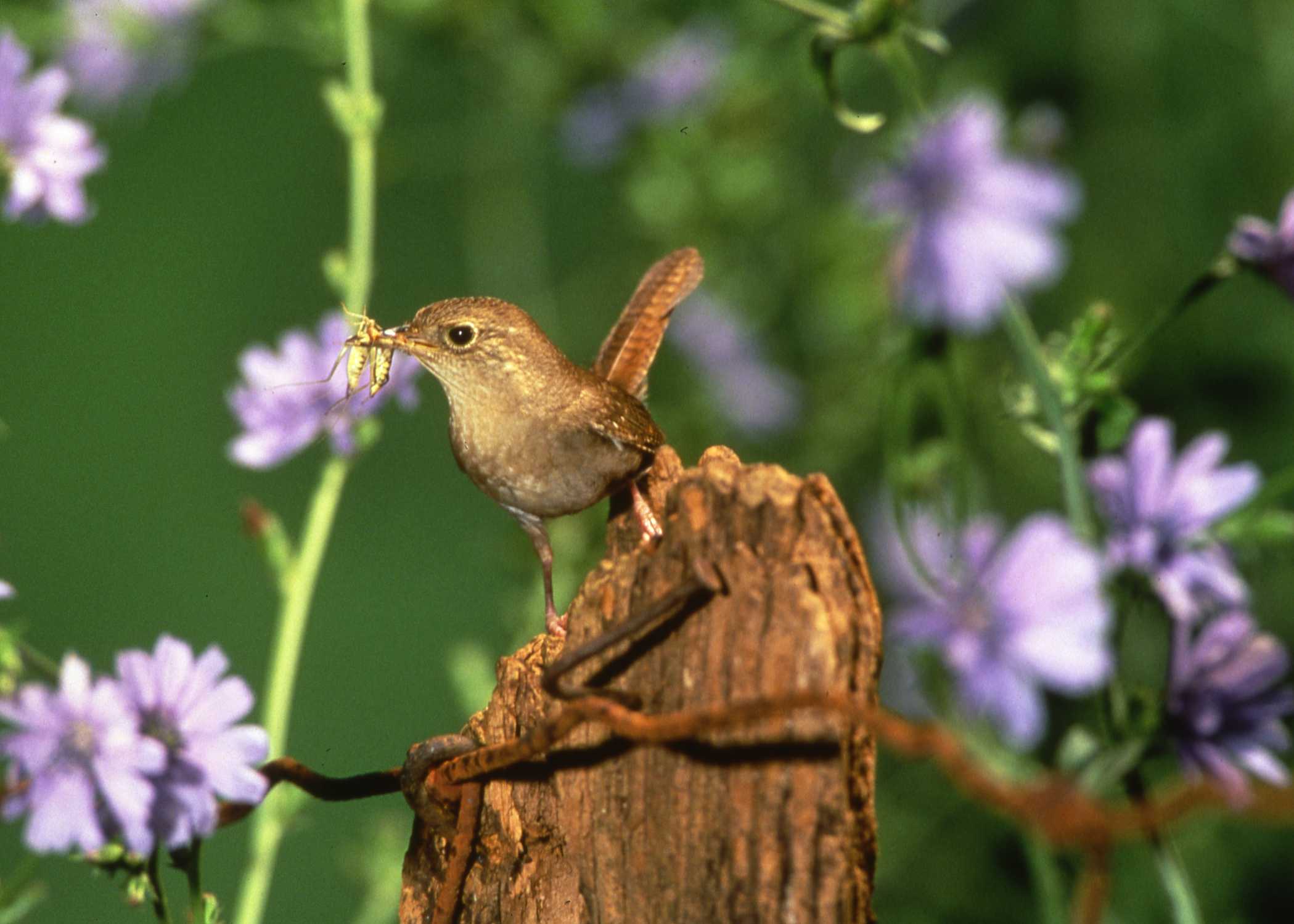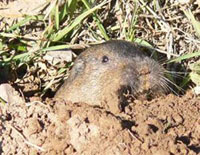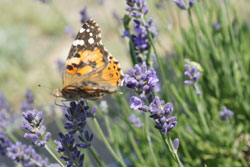Native plants
Native plants are plants that have existed in the landscape for a long time and have evolved in a particular place along with other species creating specialized relationships with other species of plants, insects, birds, mammals and many other forms of life, creating dynamic and complex ecosystems.
Incorporating native plants into home landscapes has increased in popularity, especially due to the low water use characteristics of native plants. Native plants have benefits that go beyond water savings: They provide habitat and food for other endemic species of birds, mammals reptiles and pollinators. Despite the adaptability of native plants to Colorado’s growing conditions, many native species grow only in specific ecoregions of the State. Ecoregions are determined by soils, moisture, climate and other factors. Familiarizing yourself with those factors can be the first step to planning how to incorporate native plants in your landscape.
Considerations for incorporating native plants into your landscape.
Start by examining what already grows in your landscape, observe the plants that grow in your land and surrounding areas and try to identify them. Some native plants prefer sandy soils that are well-drained while others may thrive under clay soils. Visit the Colorado Master Gardener Native Plants page to see an extensive list of native plants for landscapes and their environmental and moisture needs.
In addition to choosing the right plant for the landscape, think about the purpose and use for the space you want to revegetate. Horse or cattle pastures, pollinator habitat, reclaiming disturbed sites, preventing erosion on a high steep slope will require you to pick adequate plants for that purpose.
Manage noxious weeds. You are very likely to also find introduced, invasisve or noxious weed species while you check your surroundings for native plants. Noxious weeds can quickly form monocultures that displace native species. Some noxious weeds are also poisonous to animals and people.
If you need help identifying a plant, you cna contact your local Extension specialist or you can use one of the many online tools for plant ID. Identifying plants will help you create a management plan for the plants in your landscape and allow you to create an effective control plan for noxious weeds.
Native plant lawns
Native plant gardens can be a great way to increase diversity in your own yard, and luckly there is a plant for most types of enviroment you can provide in your yard, from sun-loving plants to partial shade wildflowers that can also survive through Colorado’s winters, storms and hot summers. There are also a variety of colors, sizes and seasons when these plant flowe so you can keep a colorful garden year-round. The Native Herbaceous Perennials for Colorado Landscapes factsheet has a thorough list of plants that can be easily found at nurseries and their characteristics and needs.
Colorado Native Plant Society also has guides for native plants by region. Click here to read and download the guide for your region.
Plant ID apps
Usually these work by uploading a picture you took from a plant of interest. The app matches the uploaded pictures with online pictures of similar plants and give you the names and pictures of plants with similar characteristics. Corroborate the presence of those plants on a book, facthseet or internet search to get more accurate results.
For better results on your plant ID app, make sure you take a clear picture with good lighting, focused on one single plant that you are interested in identifying. It’s usually easier to ID mature plants with flowers or seeds on them, but if that is not an option, pay atention to the details of the plant while you are in the field. Some small details of the plant may be the clue to tell one plant apart from other similar looking ones. Some of those details may include the color of the stem, presence of hairs on the stem or leaves, roots, size, the arrangament of leaves, leaf shape, etc.
Some of the best rated plant ID apps include:
- PictureThis
- PlantStory
- PlantNet
- PlantIn
- iNaturalist
- Google Lens
If yo would like to know more about how these apps were rated make sure to read this article from Michigan State University.
Always keep in mind that these apps are not 100% accurate all the time. Always compare the results from the apps with online pictures, books or consult with an Extension Specialist.
Books and keys
Identifying a plant with keys requires you to play close attention to plant parts and learning a few botanic terms, however, it can provide more informationand can help you identify a plant to variety level or differenciate a hybrid species. Botanists usually use dichotomous keys, which consists of questions about the characteristics of a plant, often starting by determining the plant family. Some field guides and books rely heavily on the combination of descriptions and pictures to get a general idea of the plants you are looking to identify. Both methods require you to observe plants in great detail and help you develop the skill of recognizing specific characteristics of plants.
You can find a veriety of field guides and books that are specific to wildflowers of different regions of Colorado, pine trees and other evergreens, grasses, aquatic plants. A few useful guides and books include:
- Flora of Colorado by Jennifer Ackerfield
- Colorado Flora: Western Slope. 2001. William A. Weber and Ronald C. Whittmann.
- Trees and Shrubs of Colorado. 2006. Carter, Jack and Marjorie Leggitt. Jack L. Carter.
- Grasses and Grasslike Plants of Utah. 2011. Utah State University
You can also access a longer list of useful books and guides by clicking here.
Other online resources for plant ID include
Wildflowers, ferns & trees of Colorado, New Mexico, Arizona and Utah
Want to know how to get started with plant ID?
Colorado Native Plant Master offers in-field classes in different ecoregions of the state, check the links below to see dates, location and sign-up.
Wildlife

Backyard Birding
- Rocky Mountain Bird Observatory
- Colorado Birding locations and checklists
- Cornell Lab of Ornithology – online guide to bird watching, all about birds
Dealing with Unwanted Wildlife

Pocket Gopher
- Burrowing Animal ID (prairie dogs, voles, moles, ground squirrels, and pocket gophers – Determine species by burrows and damage.
- Managing Prairie Dogs in Colorado
- Specific Animal Control – Prairie Dogs, Voles, Skunks, Birds, Snakes, Deer, Elk, etc.
- Fencing with Wildlife in Mind – Guidelines and details for constructing fences with wildlife in mind.
- Have a Wildlife Question? Contact Parks and Wildlife.
- Internet Center for Wildlife Damage Management – University of Nebraska has many fine publications and links.
- Living with Urban Wildlife
Bees and Other Pollinators

- Attracting Bats – Build a Bat House and Criteria for Successful Bat Houses
- Biology of Some Common Bees and Wasps
- Gardening For Insects – butterfly gardening, flowers that attract native bees, honey bees, and moths
- Build a Nest For Native Bees
- DriftWatch – Register your pesticide-sensitive areas, a resource for pesticide applicators
- Pollinator Mix to Attract Bees and Other Pollinators
Resources
Resources & Helpful Information
SAM Webinars and Web Videos
SAM Newsletter Articles
- Best Plants to Create Habitat – summer 2020
- Nature’s Little Serial Killer, the Loggerhead Shrike – fall 2019
- Feeding Wildlife During Winter Does Harm
- Making Beeswax Candles – spring 2016
- Americans Tend to Think About Wildlife Like their Ancestors Did – fall 2015
- Pollinators: Everyone Needs a Home – summer 2013
- Fall Birdhouse Cleaning – fall 2013
- Where Do They Go for Winter? – fall 2013
- Dragonfly Pond Watch – summer 2013
- Protecting and Enhancing Riparian Areas – fall 2012
- Improving Land for Pheasant and Other Grassland Birds – fall 2011
- Snakes – summer 2012
- Wildlife and Mountain Living – spring 2012
- Pocket Gophers Signs Are Showing Up Again – spring 2011
- Stop the Japanese Beetle – fall 2010
- Pollinators – spring 2010
- Got Voles – winter 2010
- Mountain Pine Beetle – fall 2009
CSU Factsheets
- Friendly Pesticides for Home Gardens
- Attracting Butterflies to the Garden
- Nuisance Wasps and Bees
- Beneficial Insects and Other Arthropods
- Insect Control: Soaps and Detergents
- Insect Control: Horticultural Oils
- Wildflowers in Colorado
- Native Herbaceous Perennials for Colorado Landscapes
- Herbaceous Perennials
More Wildlife Resources
- National Wildlife Federation Garden for Wildlife
- Backyard Conservation – published by NRCS, this publication will help you make your backyard more attractive by increasing food and shelter for birds, reducing soil erosion, and much more.
- National Diversity Information Source – CO’s Biological Map and Data Resource.
- Wildlife Factsheets
- The Xerces Society – Invertebrate Conservation





